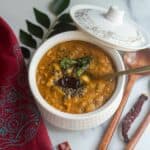Pavakkai Pitlai, also known as Bitter Gourd Black-Eyed Peas Sambar, is a traditional and authentic South Indian sambar variety made with vegetables and legumes.
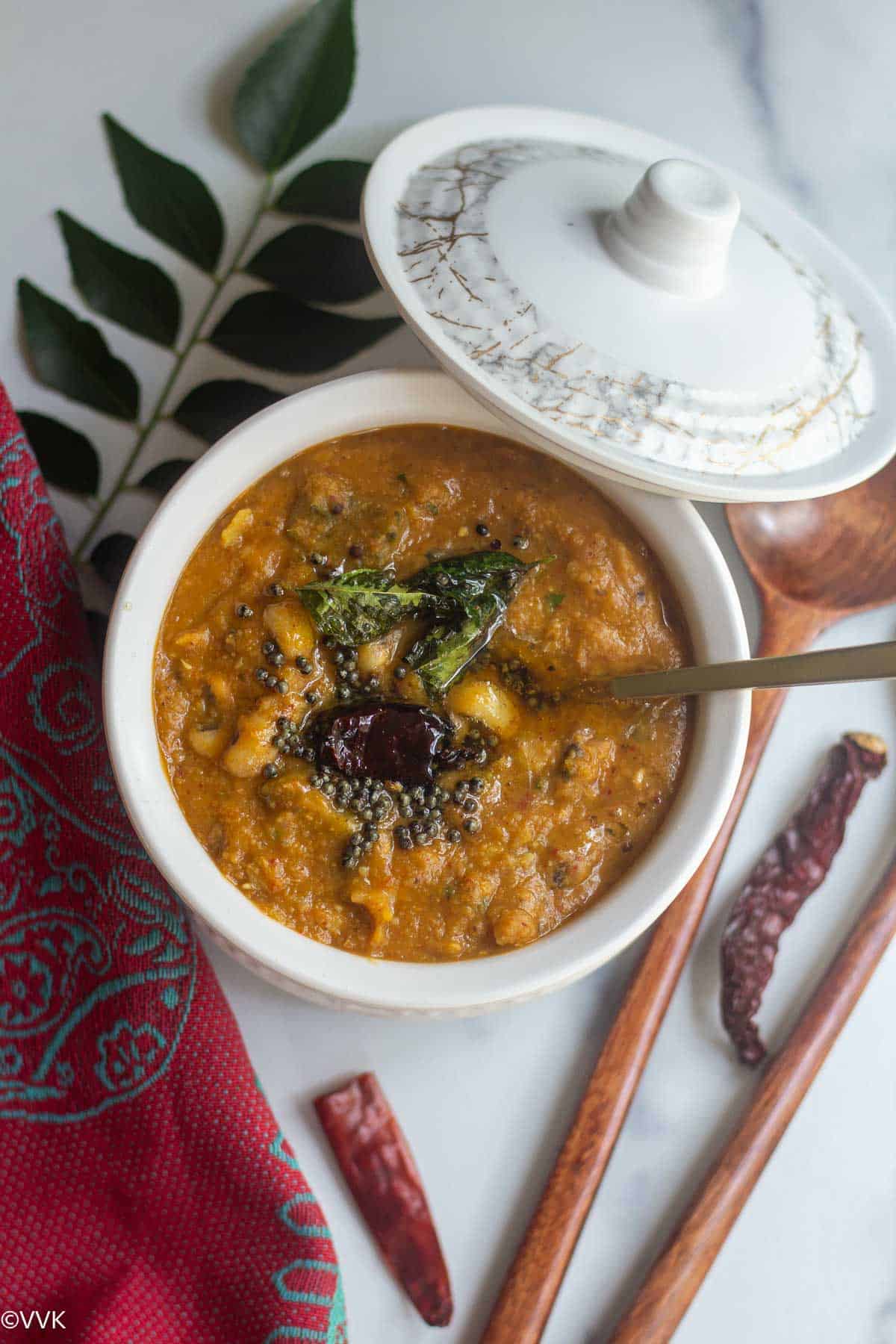
Jump to:
What is pitlai
Ok, what is pitlai? It’s a South Indian stew that is more like a sambar variety but with a difference. Typically, we don’t add legumes for sambar, but we also add legumes when making pitlai along with vegetables. While black chickpeas are the typical legume used, you can use what you have. Today, I am using cowpeas.
If you are not a big fan of bitter gourd, you can make the pitlai with cluster beans, black chickpeas, brinjal, and black chickpeas. Those are two popular combos.
The masala for pitlai is more like arachuvitta sambar, but we add more dhaniya or coriander seeds for this.
Sambar varieties
Whenever friends in the U.S. ask me how I prepare sambar daily, I smile because sambar has become synonymous with South Indian cooking. However, there’s much more to explore beyond idli, dosa, and sambar. I often wish there were an English equivalent for the word Kuzhambu. In my opinion—and based on how we prepare dishes in our household—sambar can be broadly categorized into three types (though every family has its traditional variations):
- Arachuvitta Sambar – These sambars use freshly ground masala and toor dal, with coconut being an essential ingredient.
- Paruppu Kuzhambu/Sambar – Made with toor dal and sambar powder instead of fresh masala. Coconut is optional in this version.
- Puli Kuzhambu – Unlike sambar, this doesn’t use toor dal. The masala and adding coconut or coconut milk vary across different recipes. If interested do check my kuzhambu and sambar varieties.
Beyond these, we also have Gojju/Pachadi, Gothsu, and Avial. I wonder whether to categorize avial as kootu or sambar, as it can be mixed with rice or served as a side dish. The list of South Indian dishes truly feels endless!
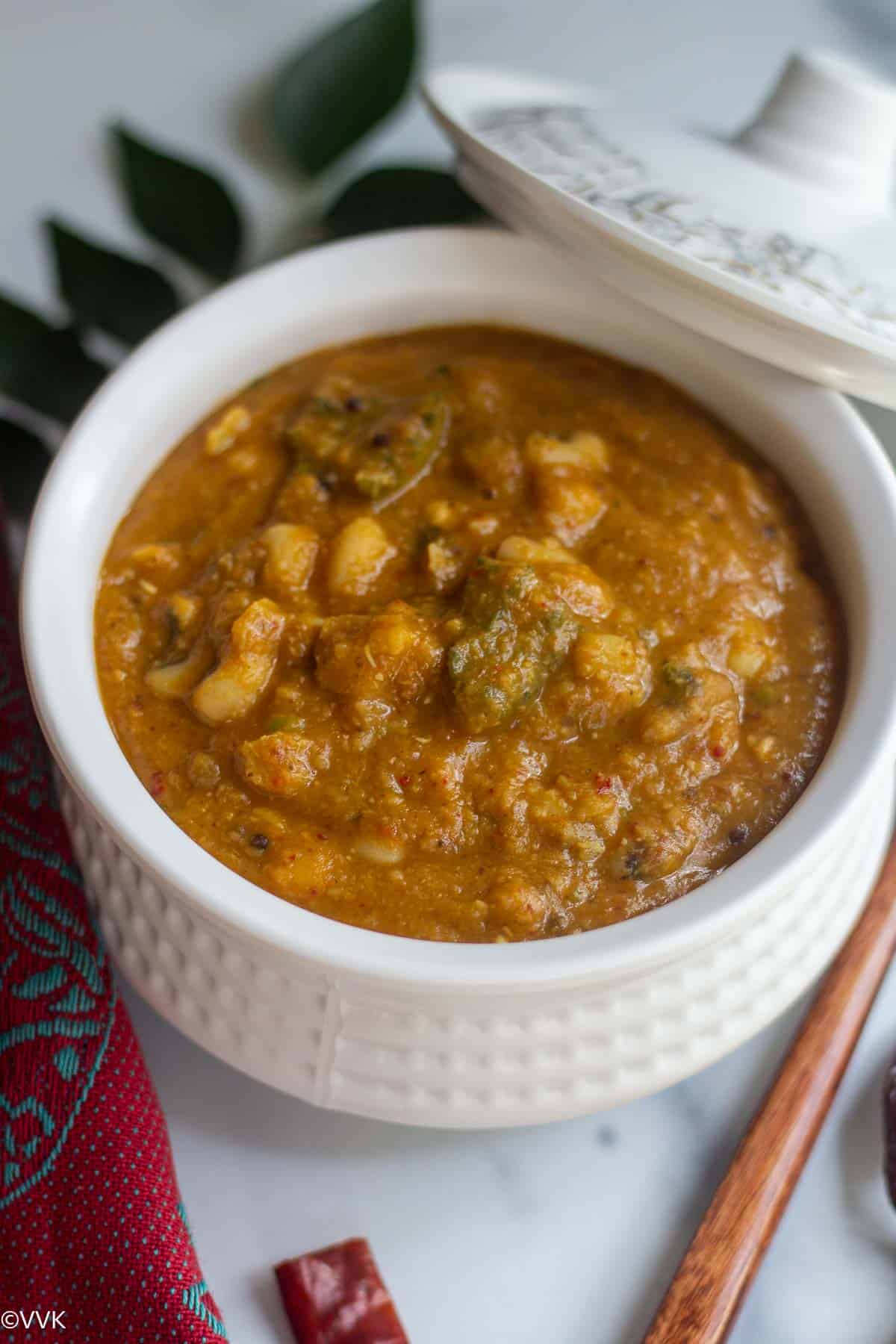
Dietary Specifications & storing suggestions
Pitali is naturally vegan, so skip asafoetida or use a gluten-free one for a gluten-free version.
Pitlai can refrigerate for 2 to 3 days and freezes well, too.
Pitali might sound like a lengthy process, but as you can see, once you have done the prep work, it’s a breeze. Please check the recipe card for the quantity of the exact ingredients.
Watch me make radish mash along with pitlai
Here is a detailed video of how I made bitter gourd pitlai and radish thuvattal for our weekend meal. You can also see how I cook the veggies and dal in my 10L pressure cooker.
How to make pavakkai pitlai
Prep the bitter gourd and cowpeas.
- Trim the edges and cut them lengthwise using a spoon, or if the bitter gourd is tender, you can scoop out the seeds using your fingers, too. Discard the inner flesh and seeds and chop the bitter gourd into small pieces.
- Soak the cowpeas overnight and discard the water.
Pressure cooking toor dal, bitter gourd, and cowpeas.
- I have used my stove-top pressure cooker to steam the vegetables and dal. I used my pressure cooker stackable vessels. I added bitter gourd and cowpeas with 1 cup of water and a pinch of turmeric in one stack.
- I added ½ cup of rinsed toor dal, 2 cups of water, a pinch of turmeric powder, and a small amount of oil in another stack. Oil helps to get mushy toor dal, which has become habitual.
- Pressure cook for three whistles.
Prepare the pitlai masala.
- Heat a pan, add a tsp of oil, and when it is hot, add ¼ cup of coriander seeds and 3 tbsps of chana dal, and mix well. Then, add five dried red chilies. I have used three normal red chilies and two Kashmiri chili varieties to get the color. But that’s optional. You can use either one variety.
- Next, add the urad dal and fenugreek seeds and roast until the lentils turn light brown and a nice aroma wafts up.
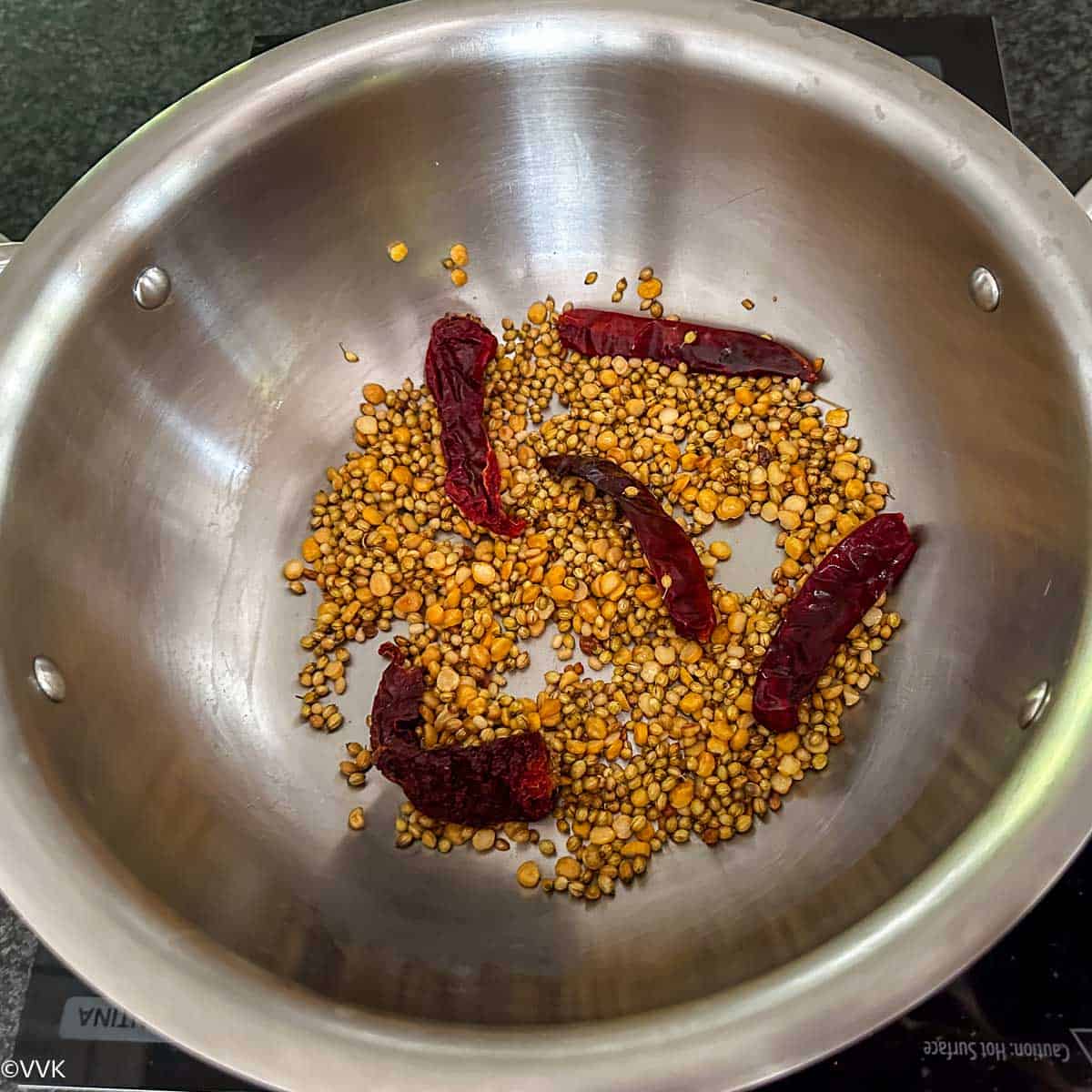
- Finally, mix the coconut well and turn off the heat. Let it cool.

Once the spices are cooled, grind it with ½ cup of water.
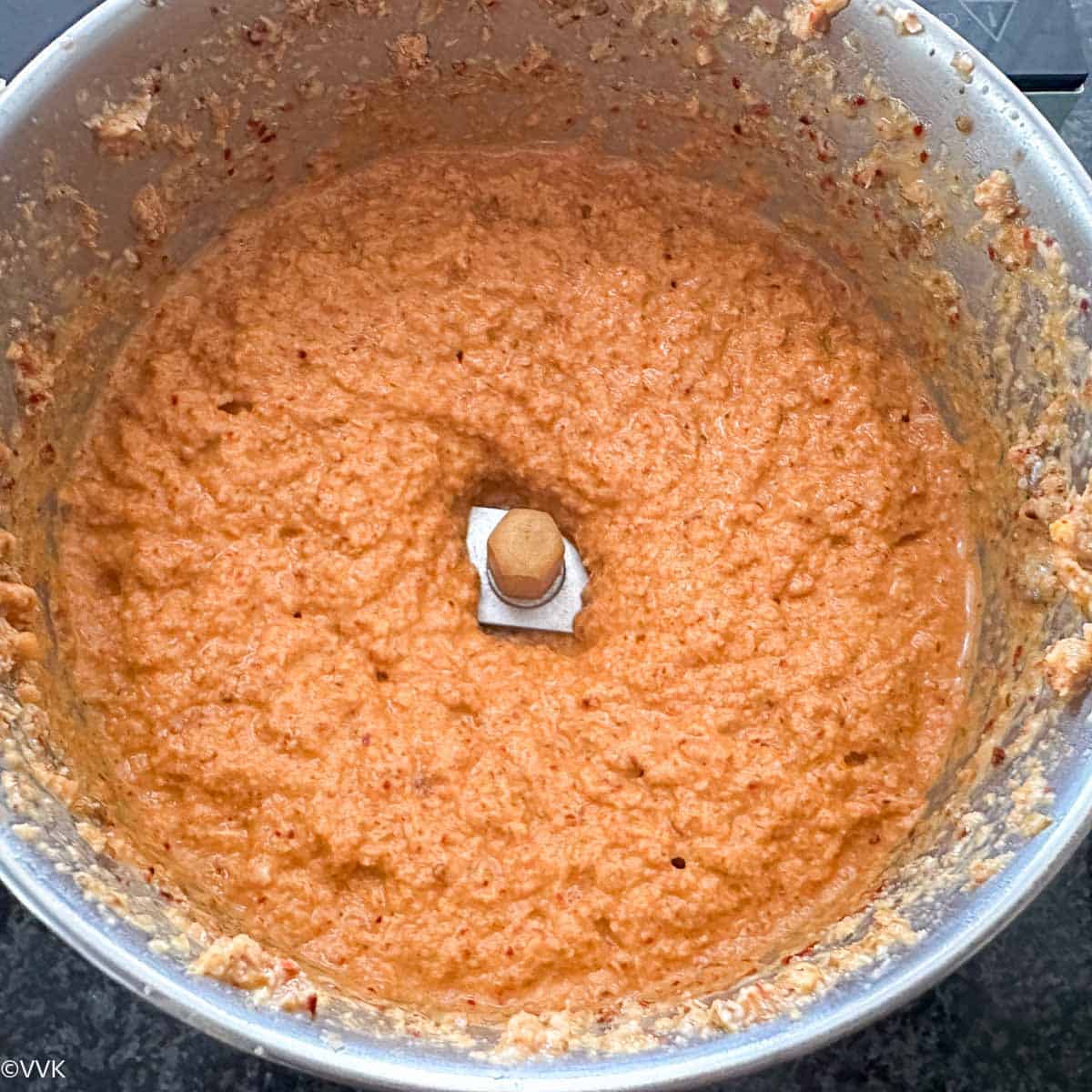
Prepare the pitlai
- Once the pressure has been released from the pressure cooker, remove the inserts and mash the toor dal.
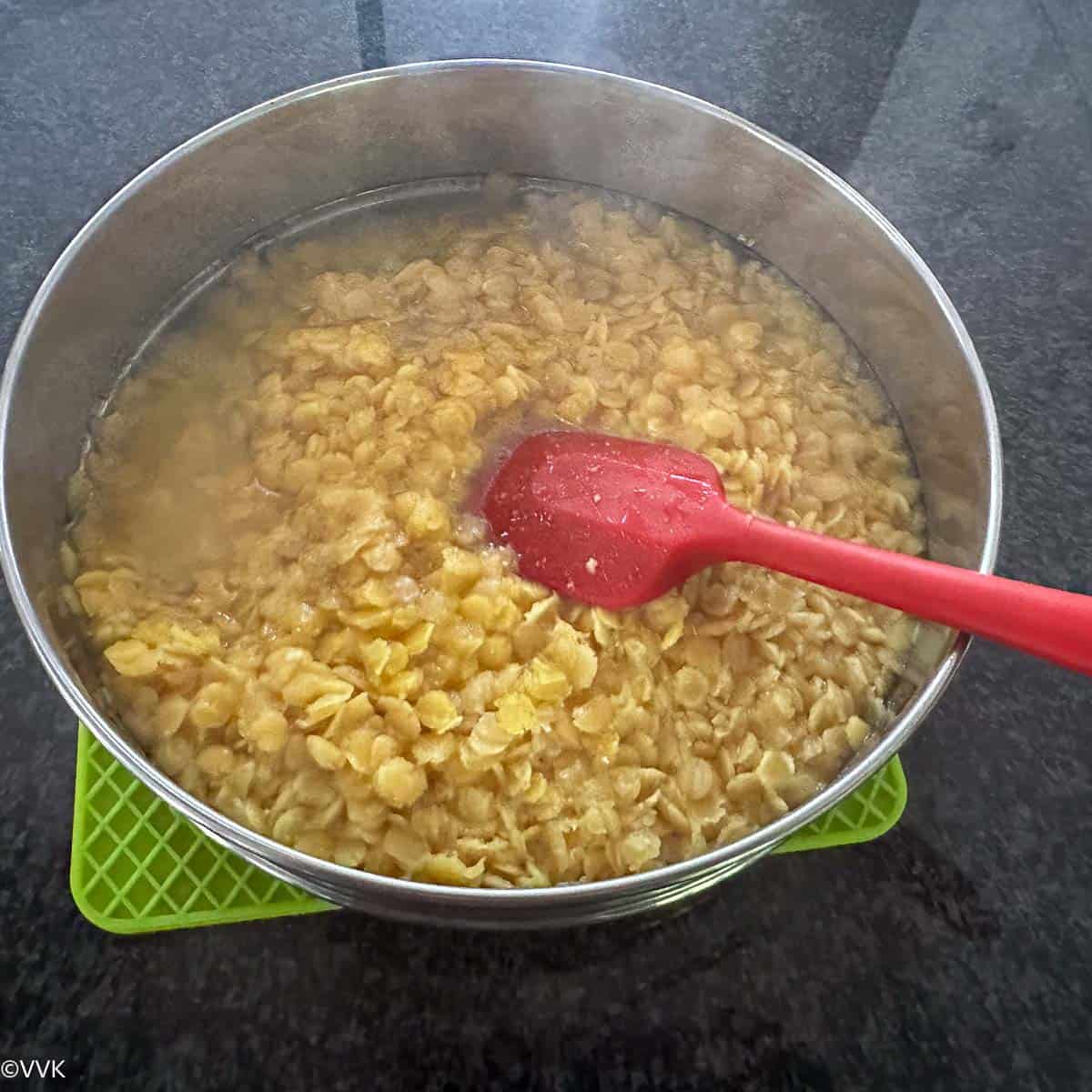
- To the bitter gourd and cowpeas mix, add 1 tbsp of tamarind paste and mix well. You don’t need to discard any water used for cooking the bitter gourd.
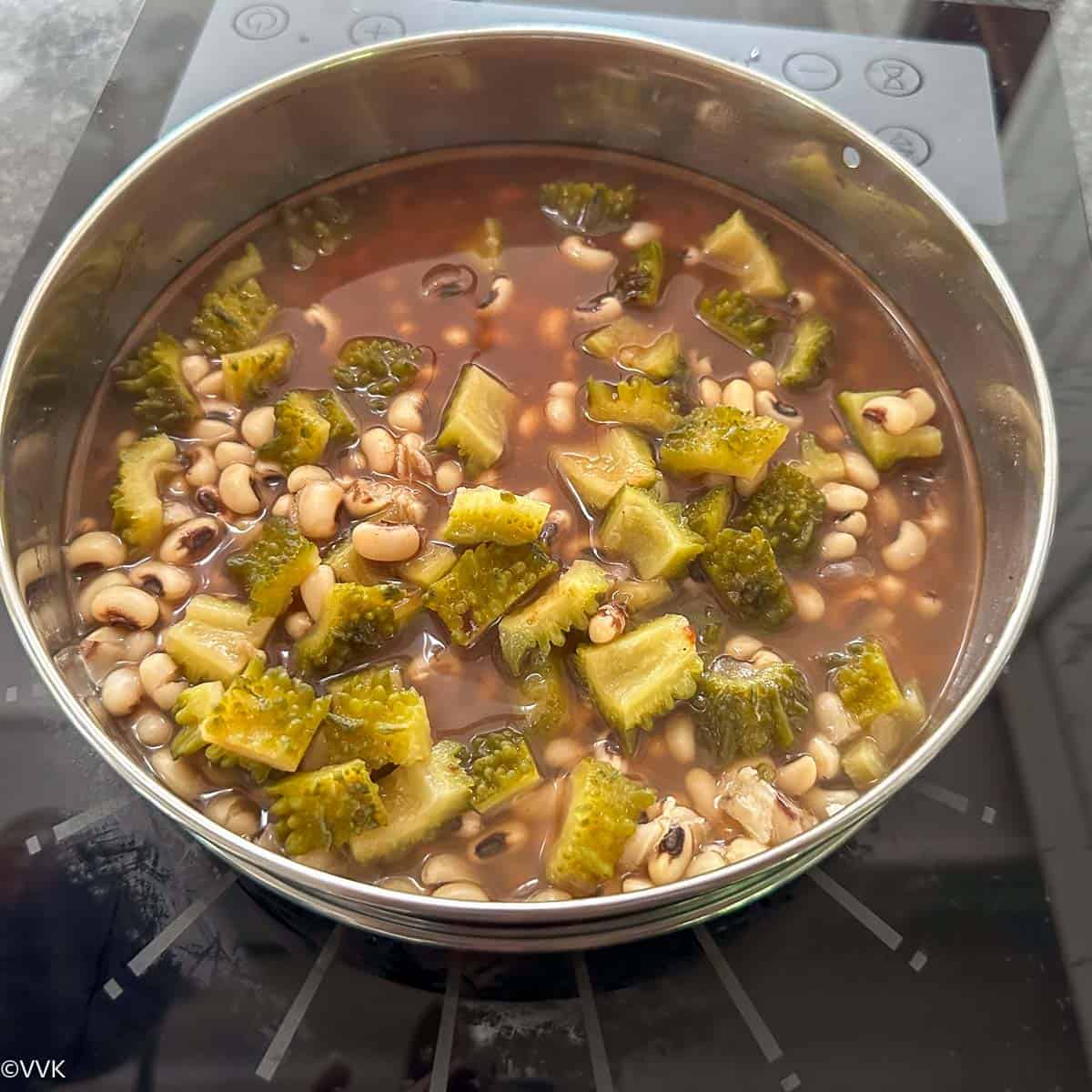
- Heat the pan and add 1 tbsp of oil. When it is hot, temper 1 tsp of mustard seeds, ½ tsp fenugreek seeds, and ⅛ tsp of asafoetida. Add a few curry leaves, let the mustard seeds splutter, and the fenugreek seeds change color.
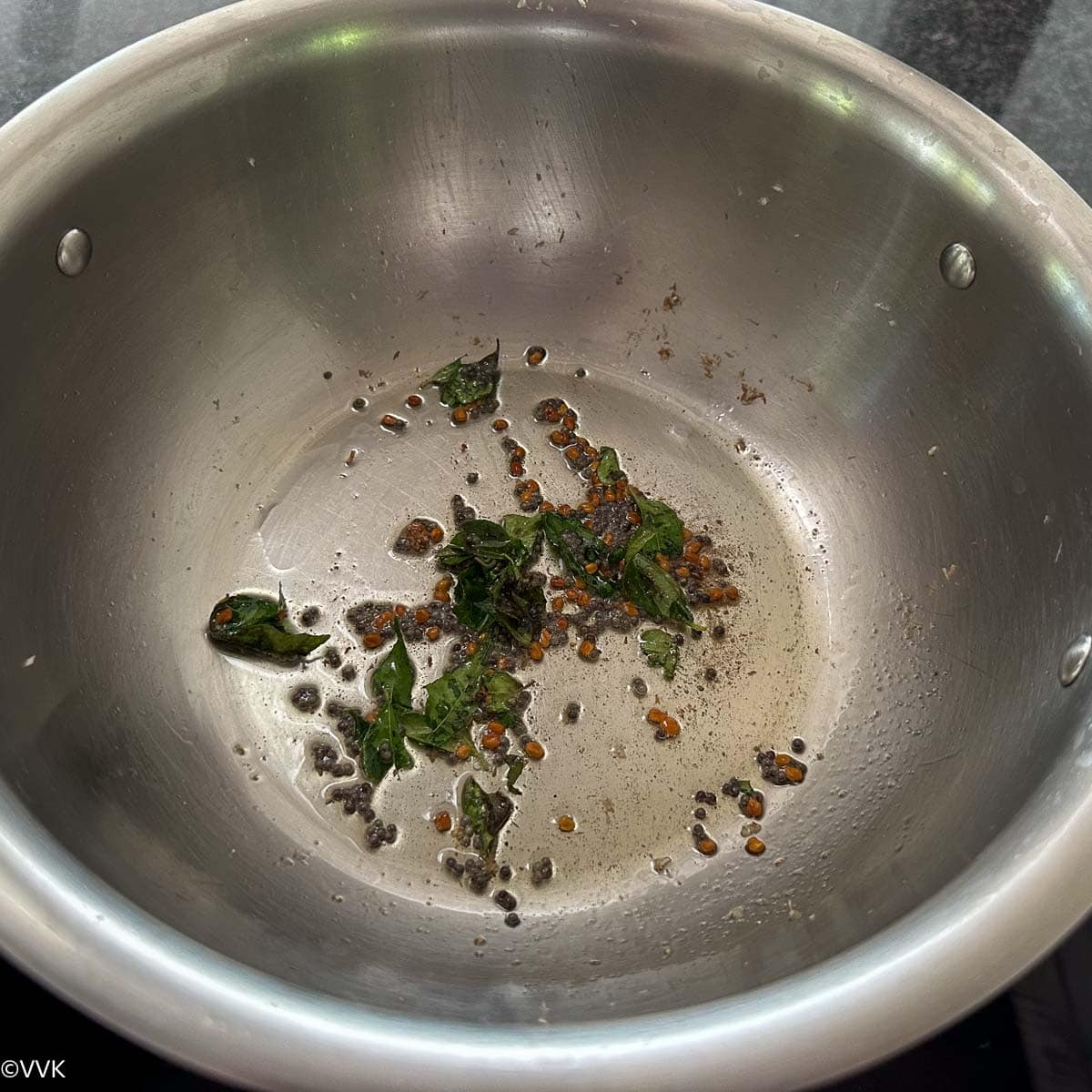
- Then, carefully mix the cooked bitter gourd and cowpeas with tamarind paste. Add two tsps of salt and mix well. Let this mixture come to a boil.

- Now add the ground paste and mix well. Rinse the mixture jar with ½ cup of water and add that. Mix well without any lumps.
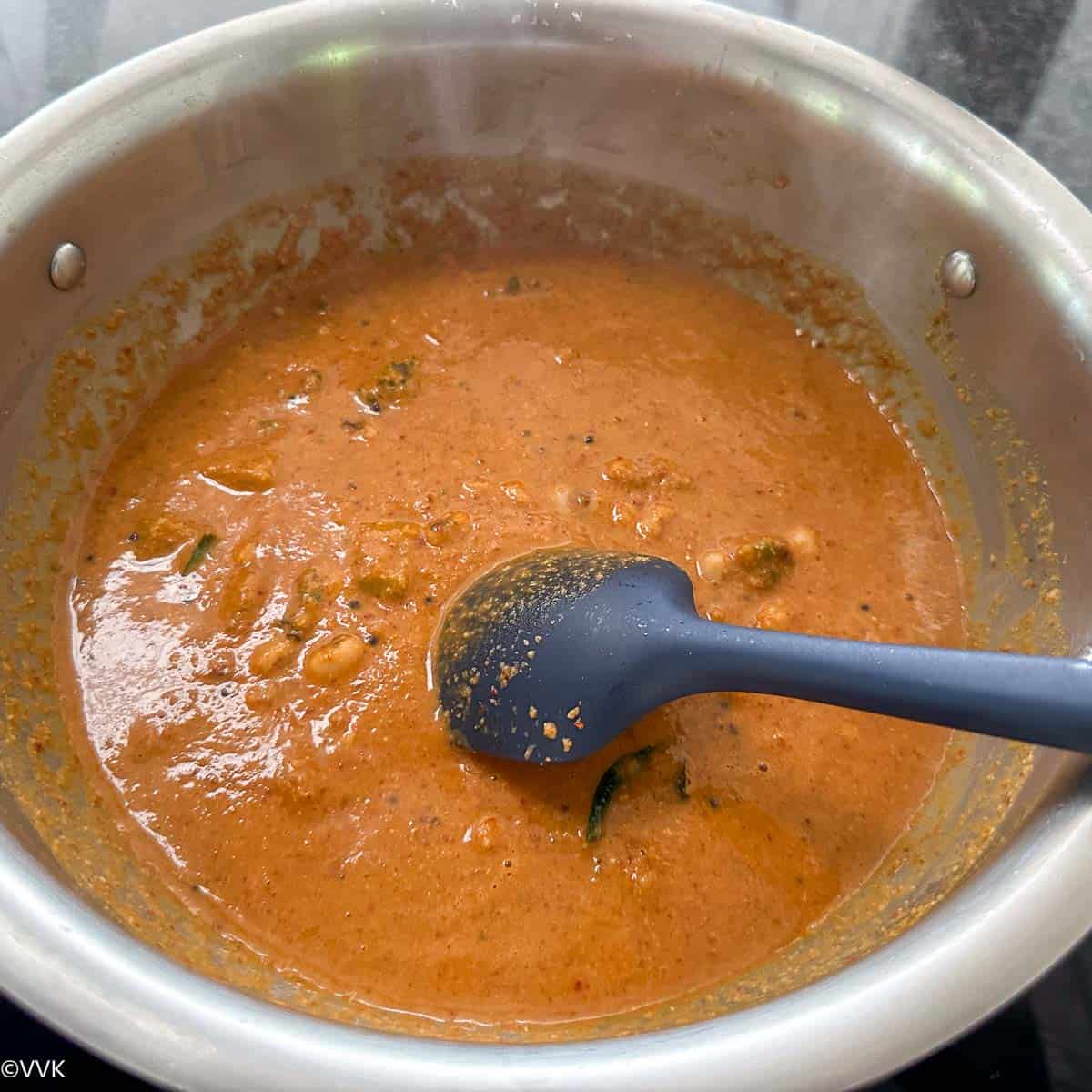
- Reduce the heat and bring this mix to a gentle boil. I usually cover the pan with the lid to avoid the splashes around.
- The pitlai mix will slowly thicken up. Now we can add the mashed toor dal. Add ¼ more cup of water and mix well. Pitlai is comparatively thicker than regular sambar. Add 1 tsp of jaggery and mix well.
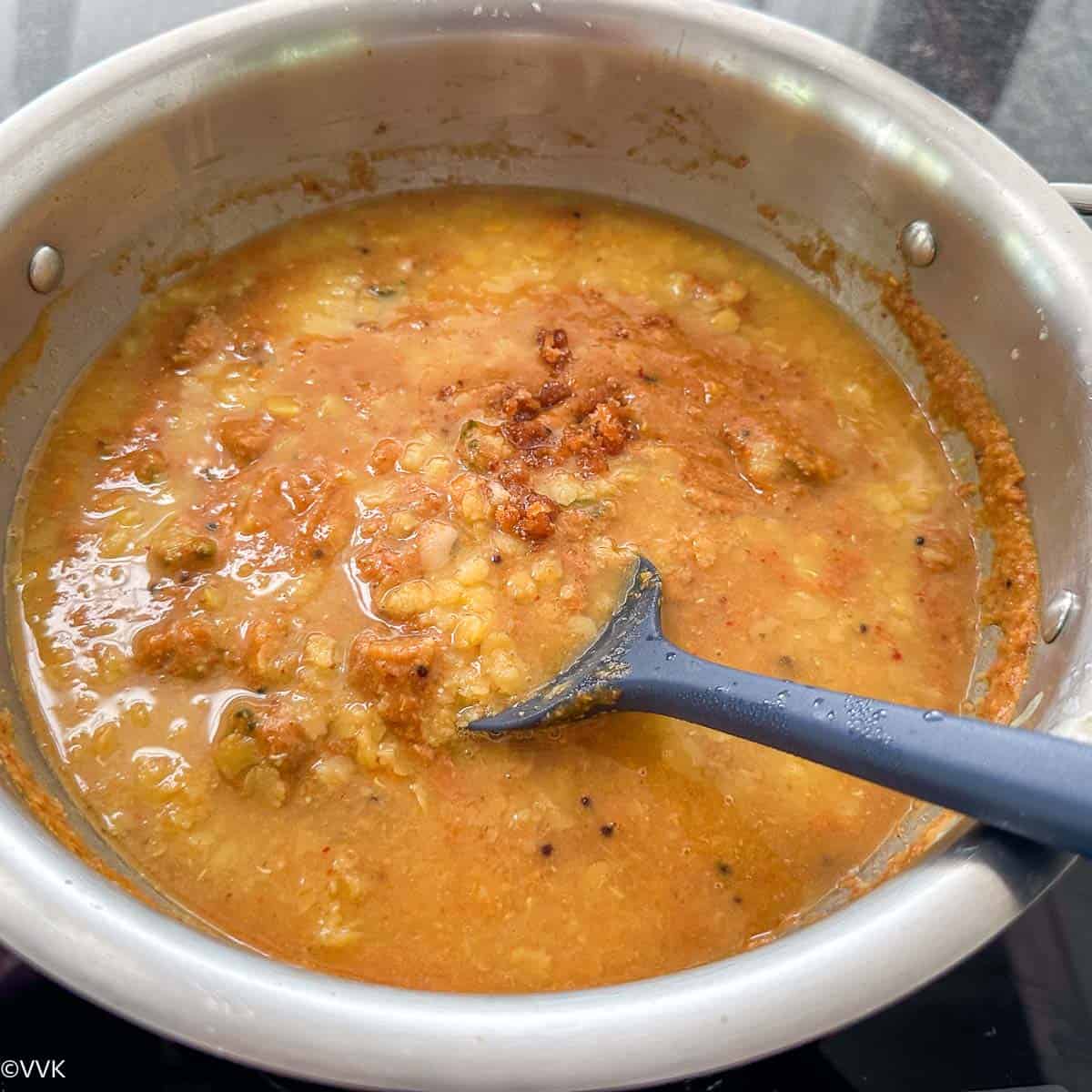
- Let it come to one gentle simmer and add a handful of cilantro, and then comes my secret ingredient – coconut oil. I add ½ tbsp of coconut oil, which adds amazing flavor to the pitlai.
Recipe Notes
- I have used two dried red chili varieties. You can use either one. And as always, adjust spices to taste.
- Adding a pinch of jaggery helps to balance the sweetness. It’s the same principle as adding a pinch of salt to sweets. This amount of jaggery is not going to make your pitlai sweet.
- Instead of bitter gourd, you can use cluster beans or brinjal to make the pitlai.
- Similarly, you can use black chickpeas or any other legumes you choose instead of cowpeas.

More sambar varieties
PS: Follow me on Instagram or join my Facebook Group for more gardening and recipe updates. If you try this vengaya sambar recipe, please don’t forget to comment and rate this recipe. If you have any questions, please leave a comment, and I will get to it asap. Make sure to follow me on my Pinterest for more healthy and delicious ideas!
📖 Recipe
Pavakkai Pitlai
Pavakkai Pitlai, also known as Bitter Gourd Black-Eyed Peas Sambar, is a traditional and authentic South Indian sambar variety made with vegetables and legumes.
Servings: 6
Calories: 153kcal
Ingredients
Other ingredients for pitlai
Instructions
Prep the bitter gourd and cowpeas.
-
Trim the edges and cut them lengthwise using a spoon, or if the bitter gourd is tender, you can scoop out the seeds using your fingers, too. Discard the inner flesh and seeds and chop the bitter gourd into small pieces.
-
Soak the cowpeas overnight and discard the water.
-
Pressure cooking toor dal, bitter gourd, and cowpeas.
-
I have used my stove-top pressure cooker to steam the vegetables and dal. I used my pressure cooker stackable vessels. I added bitter gourd and cowpeas with 1 cup of water and a pinch of turmeric in one stack.
-
I added ½ cup of rinsed toor dal, 2 cups of water, a pinch of turmeric powder, and a small amount of oil in another stack. Oil helps to get mushy toor dal, which has become habitual.
-
Pressure cook for three whistles.
Prepare the pitlai masala.
-
Heat a pan, add a tsp of oil, and when it is hot, add ¼ cup of coriander seeds and 3 tbsps of chana dal, and mix well.
-
Then, add five dried red chilies. I have used three normal red chilies and two Kashmiri chili varieties to get the color. But that’s optional. You can use either one variety.
-
Next, add the urad dal and fenugreek seeds and roast until the lentils turn light brown and a nice aroma wafts up.
-
Finally, mix the coconut well and turn off the heat. Let it cool.
-
Once the spices are cooled, grind it with ½ cup of water.
Prepare the pitlai
-
Once the pressure has been released from the pressure cooker, remove the inserts and mash the toor dal.
-
To the bitter gourd and cowpeas mix, add 1 tbsp of tamarind paste and mix well. You don’t need to discard any water used for cooking the bitter gourd.
-
Heat the pan and add 1 tbsp of oil. When it is hot, temper 1 tsp of mustard seeds, ½ tsp fenugreek seeds, and ⅛ tsp of asafoetida. Add a few curry leaves, let the mustard seeds splutter, and the fenugreek seeds change color. Then, carefully mix the cooked bitter gourd and cowpeas with tamarind paste.
-
Add two tsps of salt and mix well. Let this mixture come to a boil.
-
Now add the ground paste and mix well. Rinse the mixture jar with ½ cup of water and add that. Mix well without any lumps.
-
Reduce the heat and bring this mix to a gentle boil. I usually cover the pan with the lid to avoid the splashes around.
-
The pitlai mix will slowly thicken up. Now we can add the mashed toor dal. Add ¼ more cup of water and mix well. Pitlai is comparatively thicker than regular sambar. Add 1 tsp of jaggery and mix well.
-
Let it come to one gentle simmer and add a handful of cilantro, and then comes my secret ingredient – coconut oil. I add ½ tbsp of coconut oil, which adds amazing flavor to the pitlai.
Video
Notes
- Adding a pinch of jaggery helps to balance the sweetness. It’s the same principle as adding a pinch of salt to sweets. This amount of jaggery is not going to make your pitlai sweet.
- Instead of bitter gourd, you can use cluster beans or brinjal to make the pitlai.
- Similarly, you can use black chickpeas or any other legumes you choose instead of cowpeas.
- I have used two dried red chili varieties. You can use either one. And as always, adjust spices to taste.
Nutrition
Calories: 153kcal | Carbohydrates: 22g | Protein: 6g | Fat: 6g | Saturated Fat: 1g | Polyunsaturated Fat: 1g | Monounsaturated Fat: 3g | Trans Fat: 0.01g | Sodium: 793mg | Potassium: 393mg | Fiber: 8g | Sugar: 5g | Vitamin A: 580IU | Vitamin C: 115mg | Calcium: 75mg | Iron: 3mg
I am not a nutritionist. The nutritional information is provided as a courtesy and is an estimate only. It varies depending upon the product types or brands.
Update notes – Earlier posted in 2016. Now updated with new pictures, video and recipe card with nutritional information.


